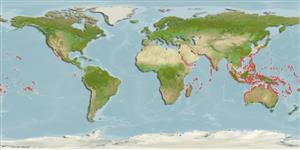Common names from other countries
Environment: milieu / climate zone / depth range / distribution range
экология
ассоциированный с рифами; пределы глубины 0 - 10 m (Ref. 96667). Tropical
Indo-Pacific: from East Africa to French Polynesia.
Length at first maturity / Size / Вес / Возраст
Maturity: Lm ? range ? - ? cm Max length : 10.0 cm CL самец/пол неопределен; (Ref. 128968)
The carapace has protruding frontal borders which are divided into four lobes (first three are rounded and the fourth is tooth-like. The body is covered with eye-like chocolate brown spots and smooth, well-defined lobules. Both front pincers are of the same size, while the walking legs are fringed with long hairs (Ref. 128968).
Adults occur in coral reefs, hidden under rocks during the day. Nocturnal (Ref. 128968). The shell and flesh of this species contain neosaxitoxin, saxitoxin, and tetrodotoxin (Ref. 107779, 128965) which have been proven to be fatal when ingested (Ref. 128965).
Life cycle and mating behavior
половая зрелость | размножение | нерест | икра | Fecundity | личинки
Members of the order Decapoda are mostly gonochoric. Mating behavior: Precopulatory courtship ritual is common (through olfactory and tactile cues); usually indirect sperm transfer.
Основная ссылка
ссылки | координатор | соавторы
MarineSpecies.org. 2050. (Ref. 3477)
Статус Красного Списка МСОП (Ref. 130435: Version 2024-1)
Статус СИТЕС (Ref. 108899)
Not Evaluated
Not Evaluated
Угроза для людей
Poisonous to eat (Ref. 107779)
Использование человеком
рыболовство: коммерческий
| FishSource | Sea Around Us
инструменты
дополнительная информация
Возраст/РазмерыростЗависимость между длиной и массой телаЗависимость между длинамиморфологияличинкичисленность
ресурсы в Интернет
Estimates based on models
Preferred temperature
(Ref.
115969): 24.6 - 29.3, mean 28.3 (based on 3236 cells).
Уязвимость
Low vulnerability (10 of 100).
Категория цены
Unknown.
